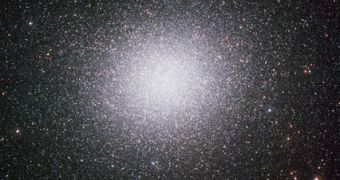The Omega Centauri is the largest glittering jewel that lights up the skies of the south. The behemoth formation that comprises millions of stars is found in the Centaurus constellation, some 17,000 light years away from Earth. It can even be observed directly, with the unaided eye, as it shines at a magnitude of 3.7, which makes it appear almost as large as the Moon. However, only a more thorough observational approach reveals its true intricacy.
The latest image, provided by the European Southern Observatory (ESO), was obtained by the Wide Field Imager (WFI), which is placed on the 2.2-meter wide Max-Planck/ESO telescope in the La Silla observatory, located in the mountains of the Chilean Atacama Desert. The 12 billion-year old Omega Centauri is the most massive of the globular clusters of our galaxy, holding nearly 10 million stars, and spanning for an approximately 150 light-year range. This kind of cluster is the oldest agglomeration of stars present in the halos that surround Milky Way-like galaxies.
Latest observations made by means of the Hubble Space Telescope and the Gemini Observatory indicated the possibility that a medium black hole (40,000 times larger than the Sun) was present at its core, as its innermost stars were moving at strange rates. The presence of the black hole was only one of the reasons that determined the experts to conclude that the Omega Centauri globular cluster was, in fact, something else at some point.
Some scientists advance a theory according to which the cluster was originally a dwarf galaxy that collided with our own Milky Way, at some point in time. The leftover formation that we see today was only the heart of the small galaxy back then, with the rest of it being obliterated by the collision. Another reason that backs up this proposition is the different age of the cluster's stars, some of which are very atypical for such a formation.

 14 DAY TRIAL //
14 DAY TRIAL //